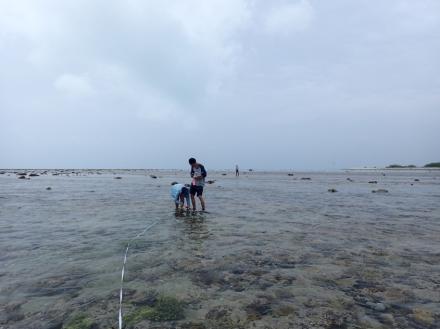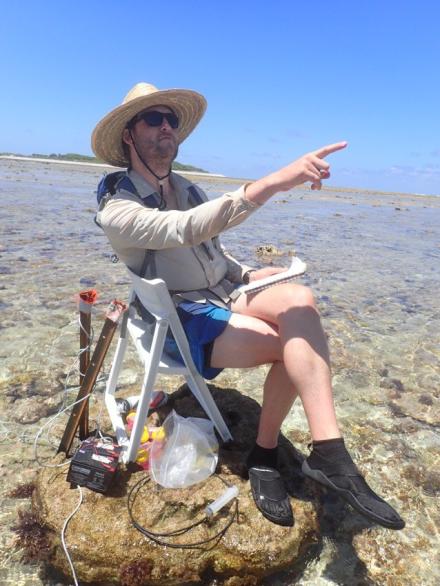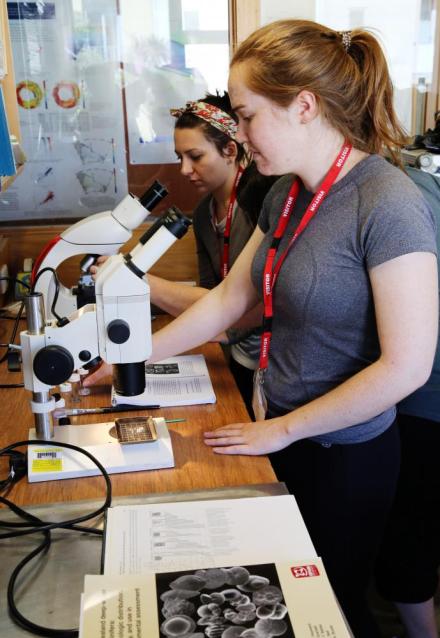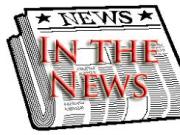
|
|
Director's Message
Happy New Year to all,
This is my favourite time of year at ANU, not least because of the ease of parking. The various student summer programs, getting to know new staff and student arrivals all contribute, and most of all it is possible to find time to think.
I am looking forward to a new year in which our efforts will begin to bear fruit on the back of many changes made in 2017.
I wish everyone a happy and successful 2018,
Steve |
|
Graduates 2017 |

|
Bianca Kallenberg
Helen Cocker
Marija Mustac
Alena Kimbrough
Craig McConnachie
Andrew De Leon
Muriel Naguit
Piers Koeford
Paula Castillo-Gonzalez
Catherine Vreugdenhil
Katherine Holland
Michael Short
Benjamin Nettersheim (Bruisten)
Thomas Haber
Tanja Pejic |
|

|
|
Coral Reefs Field Trip One Tree Island
Students braved high winds and rain while on mapping the reef. |
|

|
|
Recent student trip to One Tree had supervisors working hard directing students. |
|

|
|
Shatter-proof mobile phone screens a step closer with ANU research
Shatter-proof mobile phone screens a step closer with ANU research - ANU
An international study on glass led by ANU and the Institut de Physique du Globe de Paris in France could lead to the development of shatter-proof mobile phone screens.
Lead researcher Dr Charles Le Losq from ANU said the new knowledge, based on experiments and computer modelling, could be used to alter the structure of glass to improve resistance to fractures.
"Everyone knows how frustrating it is when you drop your mobile device and get a large crack in the screen," said Dr Le Losq from the ANU Research School of Earth Sciences.
He said glass appeared to be structured randomly, but it was actually quite ordered at the microscopic level of a few atoms.
The researchers worked on a type of glass called alumino-silicate, which is used in the screens of mobile devices.
"The glasses we analysed are mostly composed of aluminium and silicon oxides, and can also contain various elements such as sodium, potassium, calcium or magnesium - each element influences the flexibility and resistance of the glass," Dr Le Losq said.
The research builds on longstanding collaborations involving laboratories around the world, and scientists in the fields of chemistry, material science, physics and geochemistry.
Dr Le Losq said the research findings also shed light on the crucial role that lava oceans and volcanoes played in the geological evolution of Earth.
The researchers measured the viscosity of molten glass at more than 1,000 degrees Celsius and the density of the glass when cooled and formed.
"Our research findings allow better modelling of present volcanic activity, as well as of the lavas involved in the original formation of Earth and its surface," Dr Le Losq said.
He said the research could also inform ways to produce glass suitable for storing nuclear waste more effectively than current practices.
ANU and the Institut de Physique du Globe de Paris jointly conducted this research, which is published in Scientific Reports, in collaboration with researchers from France, the United Kingdom and China.
|
|

|
|
ANZIC Student Masterclass
During the week of 3rd - 8th December, two of our end-of-2nd year students, Claire Patterson and Ethan Kucka, attended the ANZIC Student Masterclass in Wellington (New Zealand) and surrounds. The packed schedule involved lectures, laboratory classes and a field trip to the Wairarapa coastal region of the Southeast of the North Island. The students examined deep-sea cores recovered by the International Ocean Discovery Program and its predecessors, ice cores from drilling in the Antarctic, fossil fauna, sedimentary structures, seismic sections, mass spectrometry facilities, small-boat surveying in Wellington Harbour, and the active tectonics of the Wellington region. Unlike the city's reputation, the weather was hot and dry throughout. |
|
|
|
|
|

|
|
This Week's Seminars:
No seminars this week. |
|
|
Follow us on Twitter:

|
|
|

|
|
Publications:
Furumura, T., & Kennett, B.L.N. (2017) Unusual strong ground motion across Japan from the 680 km deep 30 May 2015 Ogasawara Islands earthquake, J. Geophys. Res. Solid Earth, 122, 8143-8162. doi: 10.1002/2017JB014519.
featured in Research Highlights in EOS (AGU)
Rachel Wood
Comments on the chronology of Madjedbebe
Sue O'Connor, Mahirta, Sofía C. Samper Carro, Stuart Hawkins, Shimona Kealy, Julien Louys & Rachel Wood (2017)
Fishing in life and death: Pleistocene fish-hooks from a burial context on Alor Island, Indonesia.Antiquity, 360, 1541-1468
|
|

|
|
ORCID
RIMS is now live, visit rims.anu.edu.au and login using your standard ANU login credentials. The release of RIMS provides you an opportunity to familiarise yourself with your dashboard, ensure your information is correct and connect and review your researcher iDs including ORCID.
See RIMS website for a simple step-by-step guide to logging into RIMS and either registering or linking your ORCID account – it will take 2 minutes. If you have any feedback on the system, please contact the RIMS Project Team on ext. 50505 or rims.support@anu.edu.au or visit RIMS for further information.
|
|
|
Conferences, Meetings and Workshops:

|
|
AMOS-ICSHMO 2018
The Australian Meteorological and Oceanographic Society and the American Meteorological Society, are holding the Joint 25th AMOS National Conference and 12th International Conference for Southern Hemisphere Meteorology and Oceanography, AMOS-ICSHMO 2018, at UNSW Sydney 5-9 February 2018 |
|

|
|
GrantConnect - Information for researchers
What is GrantConnect?
GrantConnect provides a central location for potential grant applicants to find and access Grant Opportunities and documentation on Commonwealth grant schemes (including ARC). Anyone can sign up to receive optional email notification of new Commonwealth Grant Opportunities, relevant to their interests, as they are published. GrantConnect is part of the whole-of-government grant reform agenda led by the Department of Finance.
Why is GrantConnect being implemented?
To make it easier to identify for Commonwealth Grant Opportunities relevant to your interests. GrantConnect is part of the grant reform agenda which also includes updating and streamlining Grant Opportunity Guidelines (Funding Rules).
How does it impact me?
From 30 April 2017, Commonwealth Grant Opportunities and their associated guidelines must be published on GrantConnect. To access Grant Opportunity Guidelines and to receive optional email notifications, users will need to create a GrantConnect account. GrantConnect is ‘live’ now at www.grants.gov.au. Grant Opportunity Guidelines will no longer be published on the NHMRC website for Grant Opportunities opening after 30 April 2017.
The GrantConnect Helpdesk (run by Department of Finance) can be reached on 1300 484 145 (between 9am and 5pm ACT Local Time, Monday to Friday, excluding ACT and national public holidays) or via email ‐ GrantConnect@finance.gov.au. Watch the GrantConnect video here. |
|

|
|
Outreach Opportunities:
Over December-January we will have a lot of visitors to RSES. Please consider contacting the person listed below to volunteer to either to host a group in your laboratory or to give a talk.
1 - NYSFNational Youth Science Forum
Dates: Tuesday, 9 January 2 - 5 pm, Tuesday, 23 January 2 - 5 pm
Type of help needed: Student Session A: 14 students plus 1-2 student staff
Student Session C: 14 students plus 1-2 student staff
Contact: Charles Le Losq
2 - NSTSSNational Science Teacher Summer School
Dates: Wednesday, 10 January, 10:30 am - 1:00 pm 20 teachers – request lab visits
Type of help needed: workshops, lectures, resources
Contact: Malcolm Sambridge
3 - Science Olympiad program
Earth and Environmental Science Summer School (EESO) lectures and practical
Dates: Mon-Thurs: Jan 8-11 and 15-18
Type of help needed: 1 hr guest lecturers and/or laboratory visits on any topic in Earth Systems Science [solid earth, geophysics, geochem, fluids, environmental, etc] and Planetary Astronomy will be most welcome. The EESO students are very high ability Yr9-11 High School students who have been invited to attend Summer School, having topped an extremely challenging national selection exam. At Summer School they are put through the equivalent of a first year university course in EES but in some areas of the course the students are easily operating at levels much higher than most good first year students.
Any ANU/RSES staff and post-graduates who are in Canberra during January 2018 who would like to contribute can contact Greg to discuss how they might be able to help with a presentation that relates to their research work and/or how they might be able to show us some of the research laboratories in action.
Contact: Greg McNamara |
|

|
|
ACT MS Symposium 2017
ANU hosted the recent ACT MS Sumposium.
The symposium was attended by Commercial instrument suppliers and Mass spectrometry users from the Research school of Chemistry, Research School of Biology, UNSW School of Chemistry , Macquarie University and CSIRO Land and Water. John Foster was the only presenter from RSES even though we have a large number of mass spectrometers in the School. The symposium was reasonably well attended.Talks were given by various instrument suppliers describing their latest products, but the predominance of the talks were on the use of triple quadrupole mass spectrometers for separation and characterisation of peptides and proteins. John's talk about the SHRIMP was very different to any of the other talks in that it was about building and developing an instrument which could not simply be bought off the shelf. The time keeper was so interested in my talk that he forgot to stop me at my allotted time. |
|
|
|